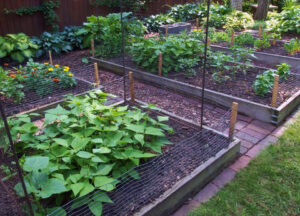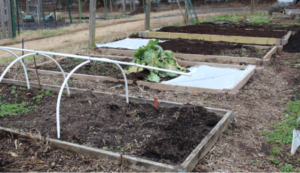Improving Your Vegetable Garden
by Carmine Carosella, Fairfax Master Gardener
Winter is the time of rest from the chores of the vegetable garden, no weeding and watering, no planting and picking. Now is the time for planning. What do I want to grow? Do I have all the supplies I need? How do I want to improve my garden?

Vegetable garden raised enclosed beds
Vegetable gardening is both science and art. The science starts with the knowledge gained from last year’s successes and failures. Do you remember when, where and what you planted last year? How did the weather affect your results? You do recall how dry it was in July, right? The sure way to remember is with record keeping. If you didn’t do it last year, this year’s planning should start with the purchase of some sort of log book. Or perhaps a self-generated, on-line document where you record seed purchases, planting dates, etc. With good record keeping you can enhance future success and avoid repeated failures.
Now is the time to plan what crops you’ll grow this year. You probably have some seeds left from last year. Take an inventory, then order more if necessary. Some seeds last for only one season in storage, for example onions, but others are good for four years or more. Probably the most excitement a gardener can have is going through the seed catalogs. The catalogs are packed with new and improved varieties, all there to entice the gardener. Sure, there’s a lot of hype but also many real breakthroughs in disease resistant varieties. Take for example Genovese basil seeds that resist the recent downy mildew problem. How about heirloom tomatoes that are now bred for disease resistance? And don’t forget about flower seeds to attract pollinators to your garden.
Okay, we’ve decided what to grow. Now where will we grow it? Everyone has heard of crop rotation but doing it is another story. And what about the weed issues that we had last year? There is a solution you might consider, permanent raised beds and walkways. How does this work? First, picture a vegetable garden with five raised beds separated with permanent walkways. Each raised bed would contain a family of related crops, such as the nightshade family (tomatoes, peppers, eggplants and potatoes). Another would grow the cucurbits (zucchini, cucumbers, winter squash, etc.). The three other beds would be for the legume, brassica and allium families.

Raised bed garden in winter
Now a five-year rotation from bed to bed is easy with the minimal of record keeping. Raised beds also allow for easier weed control along with no till gardening. The permanent pathways, covered with scrap cardboard and topped with wood mulch, become virtually weed free.
Raised beds need not be elaborate. They could just be the no-step, elevated soil areas between the permanent pathways. In the winter, they could be planted with cover crops to protect the bare soil, or even easier covered with the leaf mulch that is readily available in Fairfax County. When did you last check the soil pH? That might be the last step in improving your garden for the coming season. Good luck!
References
Weedless Gardening, Lee Reich, January 2000
Planning the Vegetable Garden, Virginia Cooperative Extension (VCE) Publication 426-312
Beginners’ Guide: Planning a Vegetable Garden, Gil Medeiros, Fairfaxgardening.org